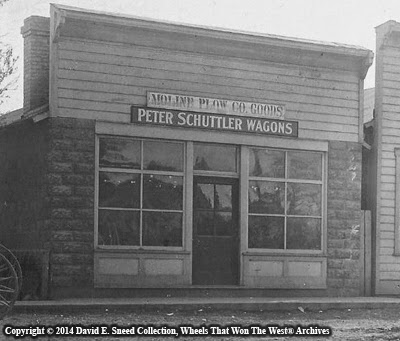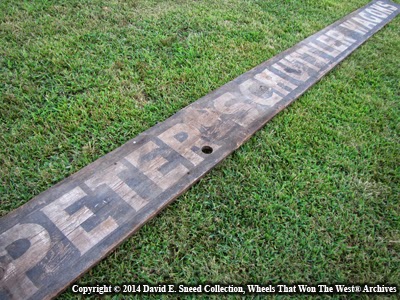In the hunt for history, one of the most exciting parts is the chase itself. The pursuit can be full of surprises and often generates a host of unforgettable memories. As intriguing as the chase may be, though, the greatest satisfaction usually comes with the actual discovery of pieces most have only read of or dreamed about. It's a thought easily echoed in our own searches as, again and again, our quests are punctuated with exceptional finds; each driving us forward in the never-ending search for lost artifacts from America's first transportation industry.
Hand-built, wooden promotional signage was once a common sight with wagon retailers.
Not long ago, we came upon another rare survivor - An original, wooden sign that would have been used as an outdoor billboard for a dealer of Peter Schuttler wagons. Schuttler, as many know, was a legendary wagon builder and highly respected brand during more than eight decades of manufacturing in Chicago, Illinois. I've written a fair amount about the firm, including a brief company bio in Driving Digest magazine a few years ago. Like Studebaker, Mitchell, Bain, Jackson, and countless other nationally-recognized brands, the Peter Schuttler Wagon Company was a strong marketer with a host of advertising tools. Most of the true outdoor pieces have either deteriorated, been destroyed, or may yet be tucked away in an attic, old barn, or similar out-of-the-way place.
While these promotional signs came in a multitude of sizes, this single plank display is one of the larger varieties, measuring almost a foot in height and 14 feet in length. Surrounded by a well-worn, blue-beaded finish, the faded white block lettering is adorned with barb-like serifs on the individual characters. The spurred font carries a unique western feel which may have been designed to leverage the company's rich history and popularity during the early growth of the West. The size of the sign is also significant as it's a strong indicator of its purpose as an outdoor piece. Larger signs were used to draw greater attention while reinforcing the dominant market position of a particular brand.

Early wagon signage was often more prominent than the name of the business establishment it hung on.
Numerous early photos in our Archives show these signs on period hardware, lumber, general mercantile, and other stores. While vintage wagon makers worked to establish exclusive sales contracts with these sellers, retailers were an independent sort and they often sold as many as a half dozen different brands from a single store. It was no doubt confusing to some buyers with so many signs and wagon names on the outside of a building. Knowing this, it's no surprise that the practice of carrying multiple brands was a regular source of contention between manufacturers and sellers of these historic wood-wheeled wagons.
If you know of other early vehicle signage, give us a shout. We enjoy the opportunity to review period advertising materials. Custom designed for optimum impact, these special pieces offer rare insights into the business side of one of the most competitive and essential industries in early America.
